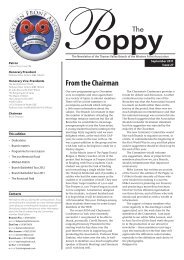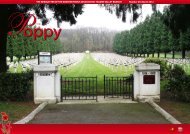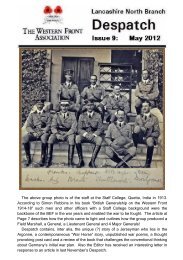Up_the_Line_July_2012.pdf - The Western Front Association
Up_the_Line_July_2012.pdf - The Western Front Association
Up_the_Line_July_2012.pdf - The Western Front Association
You also want an ePaper? Increase the reach of your titles
YUMPU automatically turns print PDFs into web optimized ePapers that Google loves.
“UP THE LINE”<br />
THE LANCASHIRE AND CHESHIRE<br />
BRANCH OF THE WESTERN FRONT<br />
ASSOCIATION<br />
<strong>July</strong> 2012<br />
CHAIRMAN’s NOTES<br />
Good evening and welcome to <strong>the</strong> <strong>July</strong> meeting.<br />
First of all, I must thank Denis McCarthy for agreeing to<br />
bring his talk forward. This is due to <strong>the</strong> planned speaker<br />
being unavailable. I am sure we will enjoy Denis’ topic of<br />
<strong>the</strong> 16th (Irish) Division.<br />
I have recently met a representative of Trafford MBC<br />
regarding <strong>the</strong> commemoration of <strong>the</strong> Great War Centenary.<br />
<strong>The</strong> meeting was very useful. Trafford have already begun<br />
thinking about <strong>the</strong>ir programme and our branch will be<br />
hopefully be invited to contribute.<br />
On Monday 6th August, Stockport Militaria’s meeting<br />
will be held at <strong>the</strong> Britannia Hotel, Stockport. <strong>The</strong> talk will<br />
be ‘<strong>The</strong> Russo-Japanese War 1904-5’, by Michael Murphy.<br />
This formed part of my MA course at <strong>the</strong> University of<br />
Leeds, so I will be attending it. Many aspects of <strong>the</strong> conflict<br />
including trench warfare, mass frontal attacks and <strong>the</strong> cult<br />
of <strong>the</strong> offensive were present. It might have been seen as a<br />
curtain raiser for <strong>the</strong> Great War. It could also be argued that<br />
European armies were influenced by it, but failed to heed<br />
<strong>the</strong> lessons it held. It would be worth a visit.<br />
As you will be aware some of us made a short trip to<br />
Ypres in May. This was an informal stroll around <strong>the</strong> area<br />
and was greatly enjoyed by <strong>the</strong> participants. It is proposed<br />
to go again next year. A possible idea could be <strong>the</strong> Retreat<br />
from Mons to Le Cateau. It would be up to individuals to<br />
arrange transport sharing etc, although we could probably<br />
co-ordinate accommodation.<br />
Terry Jackson, Chairman.<br />
last months talk<br />
Smith Dorrien & 2nd Ypres<br />
<strong>The</strong> first months of <strong>the</strong> Great War are often overlooked. Dr Bob Bushaway<br />
brought to light <strong>the</strong> antagonism within <strong>the</strong> commanders of <strong>the</strong> BEF, which<br />
were eventually to bring about a change in command in late 1915. It also<br />
became <strong>the</strong> subject of bitter recriminations after <strong>the</strong> war.<br />
Horace Lockwood Smith-Dorrien (S-D), had been given command of<br />
2nd Corps whilst <strong>the</strong> BEF was still forming up in France. John Grierson,<br />
his predecessor, had died of a heart attack en route. However, this<br />
appointment caused friction between S-D and <strong>the</strong> Army Commander,<br />
Sir John French. French later accused S-D of failures both at Mons and Le<br />
Cateau and during <strong>the</strong> 1914 Christmas Truce.. Subsequently as <strong>the</strong> British<br />
struggled to contain German advances at Second Ypres, French found a<br />
way to remove S-D from command.<br />
Friction had existed between <strong>the</strong> two prior to <strong>the</strong> war. S-D upon<br />
succeeding French at Aldershot had created a less strict regime for his<br />
soldiers. <strong>The</strong> two had also differed over <strong>the</strong> role of <strong>the</strong> cavalry. S-D disagreed<br />
that <strong>the</strong>y still had a role as spearheading attacks on <strong>the</strong> enemy. French<br />
had requested Plumer after Grierson’s death. Kitchener, not confident of<br />
French, had sent S-D instead.<br />
General H L Smith-Dorien<br />
Sir John French<br />
Following Mons, at which 2nd Corps had born <strong>the</strong> brunt of <strong>the</strong> attack of<br />
superior German numbers, <strong>the</strong> BEF had to retreat. Both Corps had become<br />
separated by <strong>the</strong> Forest of Mormal and 2nd Corps arrived at Le Cateau,<br />
formerly <strong>the</strong> HQ of French. S-D had chosen to give battle. Despite heavy<br />
casualties, 2nd Corps had checked <strong>the</strong> possibility of being overwhelmed<br />
and allowed <strong>the</strong> whole army to escape. At that time French had praised<br />
S-D’s decision.<br />
Subsequently <strong>the</strong> BEF moved back to Belgium and at First Ypres<br />
manage to hold this important city. However, <strong>the</strong> BEF was forced to hold<br />
an extensive salient, which was overlooked by high ground held by <strong>the</strong><br />
enemy.<br />
In April 1915, <strong>the</strong> Germans launched an attack in what became 2nd<br />
Ypres. By now S-D was commander of 2nd Army and in <strong>the</strong> line adjoining<br />
Canadian forces, <strong>the</strong> enemy launched a gas attack against mainly colonial<br />
French troops. <strong>The</strong> Canadians managed to protect <strong>the</strong> gap created by <strong>the</strong><br />
French soldiers who were unable to maintain <strong>the</strong>ir position and fortunately<br />
<strong>the</strong> Germans, having used <strong>the</strong> attack as an experiment did not exploit <strong>the</strong>ir<br />
success. <strong>The</strong> Germans launched a later gas attack and it became obvious to<br />
S-D that <strong>the</strong> BEF’s position was unsustainable and proposed a withdrawal<br />
towards <strong>the</strong> city to straighten <strong>the</strong> line.<br />
This gave French <strong>the</strong> excuse to undermine S-D’s position. French<br />
removed many of S-D’s troops to Plumer’s command, which made S-D’s<br />
position as a commander untenable. S-D indicated to French that in <strong>the</strong><br />
circumstances he was not able to function effectively. S-D was dismissed<br />
by French, not in person, but by a telephone call from Robertson.<br />
Dr Bushaway considered <strong>the</strong> personalities involved and how this<br />
dramatic ending of 2nd Army’s chief came about.<br />
S-D was born in 1858 and was one of a number of officers from that<br />
era who were destined to command during <strong>the</strong> Great War. <strong>The</strong>se men had<br />
served in many of <strong>the</strong> overseas <strong>the</strong>atres of operations towards <strong>the</strong> end of<br />
<strong>the</strong> 19th Century. S-D was a better commander than French. French was<br />
a brave field commander, whose exploits had stirred <strong>the</strong> nation. However<br />
he was not suited to high command. Despite his underlying distaste of<br />
S-D, it was Haig who was ultimately <strong>the</strong> main threat to his total command.<br />
As one of <strong>the</strong> Victorian generals, S-D in imperial service was decisive.<br />
Orders from London were irrelevant. It was a necessity to think on one’s<br />
feet and make on <strong>the</strong> spot decisions. Napoleon had said “Give me lucky<br />
Generals”. French was inclined to see this as risk taking. However, he made<br />
gave few decisions in writing and was often unavailable for discussion.<br />
1
S-D was aware of <strong>the</strong> aspects of modern warfare, including <strong>the</strong> effects<br />
of <strong>the</strong> Russo-Japanese War and modern ordnance and weaponry. In<br />
1915, <strong>the</strong> trenches were much more basic than <strong>the</strong> systems that evolved<br />
through 1916. <strong>The</strong> initial surprise of gas attacks meant defenders were to<br />
suffer more casualties than defenders, <strong>the</strong> reverse of later trends. <strong>The</strong> BEF<br />
in early 1915 was low in numbers and reservists were not up to scratch.<br />
If S-D can be criticised, it is over <strong>the</strong> failure to hold <strong>the</strong> Messines Ridge.<br />
Attacks to regain <strong>the</strong> ridge failed, leaving <strong>the</strong> Germans to dig in and enjoy<br />
<strong>the</strong> advantages of overlooking Ypres until June 1917. However <strong>the</strong> BEF was<br />
not alone in early offensives. <strong>The</strong> French suffered badly in an attempt on<br />
Vimy Ridge.<br />
In 1915, <strong>the</strong> BEF did not have sufficient resources to sustain serious<br />
offensives. Artillery really never met <strong>the</strong> criteria until 8th August 1918.<br />
Manpower relied on TA units coming in and later on <strong>the</strong> Service units.<br />
Failure was also to fall on <strong>the</strong> professional German Army. <strong>The</strong> Schliffen<br />
Plan was ultimately a failure. <strong>The</strong>ir plans were concentrated in <strong>the</strong> east.<br />
Initial gas experiments <strong>the</strong>re were unsuccessful due to freezing wea<strong>the</strong>r.<br />
In <strong>the</strong> west gas canisters required a north easterly wind, which was rarely<br />
experienced. <strong>The</strong> enemy had only basic masks and were reluctant to follow<br />
<strong>the</strong> gas. Thus <strong>the</strong> experimental nature of gas at Ypres. Never<strong>the</strong>less <strong>the</strong><br />
British and Empire troops were able to stem <strong>the</strong> threat. However, one of <strong>the</strong><br />
problems at second Ypres was <strong>the</strong> loss of many junior officers. Many were<br />
from public school OTCs and <strong>the</strong> losses took time to effectively replace.<br />
Overall, S-D suffered from <strong>the</strong> antagonism of Sir John French. <strong>Up</strong>on his<br />
taking over command of 2nd Army, Plumer came to <strong>the</strong> same conclusion<br />
as S-D. This time French accepted his commander’s decision. S-D was a<br />
good officer and historians generally accept that his main decisions were<br />
correct. Sir John French was clearly unsuited to high command. He was to<br />
be seen as failing at Loos. This opened <strong>the</strong> door for Haig to assume overall<br />
command. It is fortunate that he inherited an efficient officer in Plumer.<br />
An absorbing account of <strong>the</strong> battle and personal intrigues that dogged<br />
<strong>the</strong> BEF. S-D has been seen to have been harshly treated by French. Ed<br />
Captain GVS Bowlby<br />
Captain H L Skrine<br />
holds ninety-five graves, including two French soldiers. Many of <strong>the</strong> graves<br />
were destroyed by subsequent shellfire and only twenty-six actual graves<br />
are identified. <strong>The</strong> remainder have special memorial headstones.<br />
I <strong>the</strong>n headed up <strong>the</strong> road towards Hellfire Corner, calling in at Perth-<br />
China Wall Cemetery (III). This was originally used by <strong>the</strong> French, whose<br />
graves were removed after <strong>the</strong> Armistice. It was taken on, in 1917, by <strong>the</strong><br />
YPREs VISIT 14/18th May<br />
Part 2<br />
Having spent some time at Hooge Crater<br />
Cemetery, I continued on my walk. A path<br />
to <strong>the</strong> east of <strong>the</strong> cemetery follows <strong>the</strong> Old<br />
Bond Street Communication Trench (1). This<br />
brought me to <strong>the</strong> access road to Hill 62 (2). It<br />
was here that a counter attack attempted to<br />
regain <strong>the</strong> land gained in <strong>the</strong> German flame<br />
thrower attack on 30th <strong>July</strong> 1915. Two attacks<br />
failed at <strong>the</strong> cost of more than 450 casualties.<br />
2nd Lt Harry Rawlinson of <strong>the</strong> Rifle Brigade<br />
was awarded <strong>the</strong> VC and appears on <strong>the</strong><br />
Menin Gate.<br />
I returned to <strong>the</strong> Menin Road (3) and<br />
headed west. Shortly, on <strong>the</strong> nor<strong>the</strong>rn side is<br />
Cambridge Road. This formed <strong>the</strong> Birr Cross<br />
Roads, although <strong>the</strong> sou<strong>the</strong>rn road no longer<br />
exists. Both armies tunnelled here and <strong>the</strong><br />
British had dugouts and a dressing station.<br />
<strong>The</strong> name comes from <strong>the</strong> Leinsters’ depot in<br />
Ireland. A little fur<strong>the</strong>r on is <strong>the</strong> cemetery of<br />
Captain Harold Ackroyd<br />
that name (4). <strong>The</strong>re are 800 graves, including<br />
that of Captain Harold Ackroyd VC MC. He was <strong>the</strong> MO attached to 6Bn<br />
Royal Berkshires. He was killed by a sniper on 11 August 1917.<br />
I <strong>the</strong>n retraced my steps and walked up Cambridge Road, eventually<br />
crossing <strong>the</strong> N37, which was formerly <strong>the</strong> Ypres-Roulers railway line (5). On<br />
<strong>the</strong> side road are two private memorials to Captains from 1915. <strong>The</strong>se are<br />
Geoffrey Bowlby, Royal Horse Guards and Henry Skrine, 6Bn Somerset LI.<br />
Interspersed is a small wooden cross commemorating <strong>the</strong> Leicestershire<br />
Yeomanry on Frezenberg Ridge on 13 May 1915. I crossed back over <strong>the</strong><br />
N37 and followed <strong>the</strong> sou<strong>the</strong>rn edge of Railway Wood. This brought me<br />
to <strong>the</strong> RE Grave, Railway Wood. This marks <strong>the</strong> spot where 8th RE 177th<br />
Tunnelling Coy. and 4 soldiers were entombed underground on 25th<br />
September 1915.<br />
A mine had been blown in <strong>the</strong> early hours as 9Bn Rifle Brigade<br />
attacked. <strong>The</strong> 5Bn Oxs & Bucks and 5BN King’s Shropshire LI also attacked<br />
Bellewaarde Farm strong-point. <strong>The</strong> units all suffered heavily casualties.<br />
Nearby is <strong>the</strong> Liverpool Scottish Memorial which commemorates <strong>the</strong>ir<br />
attack on 16th June 1915. I <strong>the</strong>n followed <strong>the</strong> track back to <strong>the</strong> museum<br />
on <strong>the</strong> Menin Road.<br />
Being a glutton for punishment, I could not resist adding on a final stroll.<br />
I took <strong>the</strong> road adjoining Birr Cross Roads Cemetery (I) and eventually<br />
came to Tuilieres British Cemetery (II). This small picturesque cemetery<br />
Tuilieres British Cemetery<br />
Railway Wood<br />
2
OFF THE BEATEN TRACK<br />
Mendinghem British Cemetery<br />
Location<br />
Mendinghem Cemetery is 8 km north of Poperinge. Coming into <strong>the</strong> town<br />
take <strong>the</strong> ring road <strong>the</strong>n take <strong>the</strong> N308 to Proven. Go through <strong>the</strong> town.<br />
After about a mile <strong>the</strong> cemetery is on <strong>the</strong> left, down a lane at <strong>the</strong> side of<br />
a house.<br />
Demarcation Stone<br />
2BN Scottish Rifles, whose predecessors had been raised in Perth. It was<br />
also near to <strong>the</strong> Great Wall of China communication trench. <strong>The</strong> cemetery<br />
was used for consolidation after <strong>the</strong> war and contains some 2,790 graves.<br />
I continued to <strong>the</strong> large roundabout which now stands on <strong>the</strong> site of<br />
Hellfire Corner (IV). On <strong>the</strong> Ypres junction is a helmeted demarcation<br />
stone, marking <strong>the</strong> fur<strong>the</strong>st point reached by <strong>the</strong> enemy. By now I was<br />
beginning to tire. A final walk via <strong>the</strong> Menin Gate and <strong>the</strong> main square,<br />
brought me back to my hotel and a well earned soak in <strong>the</strong> bath.<br />
To be concluded. Ed.<br />
A good friend to our branch Tony Noyes passed away<br />
recently. RIP Tony! Michael Platt<br />
TONY NOYES<br />
1939 - 2012<br />
Tony joined <strong>the</strong> WFA in its earliest days<br />
and soon joined <strong>the</strong> national committee,<br />
serving as Branch Coordinator, Vice-<br />
Chairman and, later, Chairman. He<br />
believed his first duty as Chairman<br />
should be to organise <strong>the</strong> attendance<br />
of <strong>the</strong> <strong>Association</strong> and its members at<br />
<strong>the</strong> Cenotaph on November 11th and to<br />
restore <strong>the</strong> two minute silence at 11am.<br />
This would be followed by a Service of Remembrance at <strong>the</strong><br />
Guards’ Chapel. Held for <strong>the</strong> first time in 1994, this ceremony has<br />
struck a national chord and similar ceremonies are now held in many<br />
places across <strong>the</strong> UK.<br />
<strong>The</strong> attendance at <strong>the</strong> Cenotaph has grown from a ga<strong>the</strong>ring<br />
of fifty or so, to <strong>the</strong> present day, when thousands come toge<strong>the</strong>r,<br />
including representatives of <strong>the</strong> government, members of <strong>the</strong><br />
Defence Staff, military attachés from many embassies, schools and<br />
<strong>the</strong> general public.<br />
Between 2000 and 2004 he acted as Parade Marshal for <strong>the</strong><br />
Armistice Day ceremony at <strong>the</strong> Menin gate.<br />
He visited all <strong>the</strong> important European battlefields of <strong>the</strong> Great<br />
War and embarked on a series of “epics” walking <strong>the</strong> ground on <strong>the</strong><br />
Somme, <strong>the</strong> Marne, <strong>the</strong> Aisne, Ypres and above all Verdun and his<br />
beloved Argonne. His passion was always directed toward Verdun<br />
and <strong>the</strong> Argonne, and over <strong>the</strong> years he made many private visits to<br />
that sector walking <strong>the</strong> ground and re-discovering many lost bunkers,<br />
trench systems and sites of individual importance such as <strong>the</strong> Butte<br />
de Vauquois or Lachalade Abbey where <strong>the</strong> Garibaldi bro<strong>the</strong>rs are<br />
commemorated.<br />
His last few years were blighted by increasing illness; but for as<br />
long as he could he would return to his spiritual home in <strong>the</strong> Argonne<br />
and Verdun with his wife Christina, to walk in <strong>the</strong> steps of <strong>the</strong> French<br />
and German soldiers for whom he had such regard and respect.<br />
We remember a man who through his passion for all matters<br />
pertaining to <strong>the</strong> Great War ignited enthusiasm for <strong>the</strong> history<br />
of that cataclysmic event in many o<strong>the</strong>r hearts. This passion was<br />
rightly rewarded and recognised two years ago by <strong>the</strong> WFA with his<br />
appointment as an Honorary Vice-President of <strong>the</strong> <strong>Association</strong>, an<br />
accolade by which he was greatly touched. Tim Tawney.<br />
History<br />
<strong>The</strong> cemetery was begun by <strong>the</strong><br />
46th Casualty Clearing Station<br />
(1 st /1 st Wessex) in June 1916. <strong>The</strong><br />
first burials did not take place until<br />
August 1916. It stayed in use until<br />
September 1918. <strong>The</strong> CCS first had<br />
200 beds, but for <strong>the</strong> start of Third<br />
Ypres this was increased to 1,300.<br />
Four more CCSs where stationed<br />
around <strong>the</strong> area. <strong>The</strong> 61 st was<br />
staffed by Americans. <strong>The</strong> three<br />
o<strong>the</strong>rs being <strong>the</strong> 12 th , 46 th and <strong>the</strong><br />
64 th . <strong>The</strong>re where some French<br />
burials in May and <strong>July</strong> 1918, but<br />
<strong>the</strong>se were later removed.<br />
<strong>The</strong>re are three men in this cemetery who where shot at dawn. <strong>The</strong>y<br />
are Private John Hyde of <strong>the</strong> 10th King’s Royal Rifle Corps in Sept 1917,<br />
Private Charles Britton of <strong>the</strong> 1/5th Royal Warwickshires also in Sept 1917<br />
and Private David Gibson of <strong>the</strong> 12th Royal Scots who was executed in<br />
Sept 1918.<br />
Also in <strong>the</strong> cemetery is Lt. Colonel Bertram Best-Dunkley VC of <strong>the</strong><br />
2/5th Lancashire Fusiliers, who died of wounds on <strong>the</strong> 5th August 1917.<br />
His VC was awarded for his actions on <strong>the</strong> opening day of <strong>the</strong> Third Ypres,<br />
31st <strong>July</strong> 1917.<br />
In <strong>the</strong> attack his battalion<br />
became disorganised, so he<br />
went forward and rallied his<br />
men to take <strong>the</strong>ir objectives. <strong>The</strong><br />
Fusiliers sustained heavy losses,<br />
but his leadership helped <strong>the</strong>m<br />
to succeed. In <strong>the</strong> evening he<br />
took <strong>the</strong> Battalion Headquarters<br />
into battle to defeat <strong>the</strong> German<br />
counter-attack, during which he<br />
was mortally wounded.<br />
In <strong>the</strong> cemetery are over 2,300<br />
British and Commonwealth troops,<br />
Mendingam British Cemetery<br />
Lt. Colonel Bertam Best-Dunkley VC<br />
50 Germans and several Chinese.<br />
Thanks to Mike Platt for this. ED.<br />
Museum of <strong>the</strong> Manchester Regiment –<br />
Discovery Day 2012<br />
SOLDIERS from <strong>the</strong> past will be waiting to tell you <strong>the</strong>ir story<br />
when <strong>the</strong> award-winning Museum of <strong>the</strong> Manchester Regiment,<br />
Ashton-under-Lyne Town Hall, holds its sixth annual Discovery<br />
Day on Wednesday, August 1 2012.<br />
Visitors will be able to meet First World War British troops, or<br />
Tommies as <strong>the</strong>y were nicknamed; foot soldiers commanded by<br />
<strong>the</strong><br />
Duke of Wellington at <strong>the</strong> start of <strong>the</strong> 19th century and <strong>the</strong>ir<br />
French Napoleonic equivalent, as well as members of <strong>the</strong> British<br />
Army serving today.<br />
In addition, <strong>the</strong>re will be a variety of military vehicles on <strong>the</strong><br />
market square and all for free.<br />
<strong>The</strong> event runs from 11am to 3pm. Everyone is welcome and<br />
<strong>the</strong> day is suitable for all ages. <strong>The</strong>re’s no need to book – just<br />
drop in.<br />
Cllr Jackie Lane, Tameside Council’s assistant executive member<br />
for heritage and tourism, said: “I’ve been to nearly all <strong>the</strong><br />
Discovery Days and <strong>the</strong>y really are a great day out. <strong>The</strong> various<br />
soldiers and <strong>the</strong>ir stories are extremely interesting.”<br />
For more information, telephone 0161 342 2254<br />
3
TONIGHT’S TALK -<br />
16th (Irish) Division<br />
<strong>The</strong> British army’s 16th (Irish) Division was raised September 11, 1914, part<br />
of <strong>the</strong> second wave of Field Marshal Kitchener’s volunteer “New Army”<br />
divisions designed to augment Britain’s six professional divisions which<br />
Kaiser Wilhelm II had described as a “Contemptible Little Army.”<br />
Formed in sou<strong>the</strong>rn Ireland under <strong>the</strong> command of Lieutenant-General<br />
Sir Lawrence Parsons, himself an Irish Protestant, <strong>the</strong> division was <strong>the</strong><br />
embodiment of Nationalist and Catholic Ireland. Indeed, Parsons received<br />
orders to clear <strong>the</strong> division’s 47th Brigade of its earlier recruits in order<br />
to receive men from <strong>the</strong> paramilitary National Volunteers who were<br />
encouraged to join this “Irish Brigade” by Nationalist MP John Redmond*.<br />
<strong>The</strong> Flag 1914. Redmond presents a colour to <strong>the</strong> Volunteers.<br />
In December 1915, <strong>the</strong> division moved to France, joining <strong>the</strong> British<br />
Expeditionary Force (BEF), under <strong>the</strong> command of Irish Major General<br />
William Hickie, and spent <strong>the</strong> duration of <strong>the</strong> First World War in action<br />
on <strong>the</strong> <strong>Western</strong> <strong>Front</strong>. Following enormous losses at <strong>the</strong> Somme,<br />
Passchendaele and Ypres, <strong>the</strong> Division required a substantial refit in<br />
England between June and August 1918, which involved <strong>the</strong> introduction<br />
of many non-Irish battalions. <strong>The</strong> division served as a formation of <strong>the</strong><br />
United Kingdom’s British Army during World War I.<br />
History<br />
<strong>The</strong> Division began forming as part of <strong>the</strong> K2 Army Group towards <strong>the</strong><br />
end of 1914 after Irish recruits in <strong>the</strong> early days of <strong>the</strong> war from England<br />
and Belfast first filled <strong>the</strong> ranks of <strong>the</strong> 10th (Irish) Division before being<br />
assigned to <strong>the</strong> 16th Division, formed around a core of National Volunteers.<br />
Initial training began in Ireland at Fermoy, Munster; recruits also trained at<br />
Buttevant. It moved to Aldershot<br />
in England for more intensive<br />
training in September 1915. After<br />
thirteen weeks, <strong>the</strong> formation was<br />
deployed to Etaples in France,<br />
joining <strong>the</strong> BEF, from where it left<br />
on December 18 for that part of <strong>the</strong><br />
front in <strong>the</strong> Loos salient, under <strong>the</strong><br />
command of Irish Major General<br />
William Hickie. It spent <strong>the</strong> rest of<br />
<strong>the</strong> war on <strong>the</strong> <strong>Western</strong> <strong>Front</strong>.<br />
At Loos, in January and February<br />
1916, <strong>the</strong> division was introducted<br />
to trench warfare and suffered<br />
greatly in <strong>the</strong> Battle of Hulluch, 27–<br />
29 April, (during <strong>the</strong> Easter Rising in<br />
Ireland). Personnel raided German<br />
trenches all through May and June,<br />
and in late <strong>July</strong> <strong>the</strong>y were moved to<br />
<strong>the</strong> Somme Valley where <strong>the</strong>y were<br />
intensively engaged in <strong>the</strong> Battle<br />
of <strong>the</strong> Somme. <strong>The</strong> 16th division<br />
played an important part in<br />
capturing <strong>the</strong> towns of Guillemont<br />
and Ginchy, although <strong>the</strong>y suffered<br />
massive casualties. During <strong>the</strong>se<br />
successful actions between 1<br />
and 10 September casualties<br />
Guillemont and Ginchy Memorial amounted to 224 officers and 4,090<br />
men; despite <strong>the</strong>se very heavy losses <strong>the</strong> division gained a reputation as<br />
first-class shock troops. Out of a total of 10,845 men, it had lost 3,491 on<br />
<strong>the</strong> Loos sector between January and <strong>the</strong> end of May 1916, including<br />
heavy casualties from bombardment and a gas attack at Hulluch in April<br />
Blletting of this order was fatal to <strong>the</strong> division’s character, for it had to be<br />
made good by drafts from England.<br />
In early 1917, <strong>the</strong> division took a major part in <strong>the</strong> Battle of Messines<br />
alongside <strong>the</strong> 36th (Ulster) Division, adding to both <strong>the</strong>ir recognition and<br />
reputation. <strong>The</strong>ir major actions ended in <strong>the</strong> summer of 1917 at <strong>the</strong> Battle<br />
of Passchendaele after coming under <strong>the</strong> command of General Hubert<br />
Gough and <strong>the</strong> Fifth Army. In <strong>July</strong> 1917, during <strong>the</strong> Third Battle of Ypres,<br />
although both divisions were totally exhausted after 13 days of moving<br />
weighty equipment under heavy shelling, Gough ordered <strong>the</strong> battalions<br />
to advance through deep mud towards well fortified German positions<br />
left untouched by totally inadequate artillery preparation. By mid August,<br />
<strong>the</strong> 16th had suffered over 4,200 casualties, <strong>the</strong> 36th almost 3,600, or more<br />
than 50% of <strong>the</strong>ir numbers. General Haig was very critical of Gough for<br />
“playing <strong>the</strong> Irish card”.<br />
<strong>The</strong> 16th Division held an exposed position from early 1918 at Ronssoy<br />
where <strong>the</strong>y suffered more heavy losses during <strong>the</strong> German Spring<br />
Offensive in March and being practicaally wiped out in <strong>the</strong> retreat which<br />
followed Operation Michael, when <strong>the</strong>y helped to finally halt <strong>the</strong> German<br />
attack prior to <strong>the</strong> Battle of Hamel. <strong>The</strong> decision was <strong>the</strong>n made to break<br />
up <strong>the</strong> division, <strong>the</strong> three surviving Service battalions were posted<br />
to o<strong>the</strong>r formations. On 14 June <strong>the</strong> division returned to England for<br />
“reconstitution”. <strong>The</strong> Conscription Crisis of 1918 in Ireland meant that fewer<br />
Irish recruits could be raised so that <strong>the</strong> 16th Division which returned to<br />
France on 27 <strong>July</strong> contained five English Battalions, two Scottish Battalions<br />
and one Welsh Battalion. <strong>The</strong> only original Battalion left was <strong>the</strong> 5th Royal<br />
Irish Fusiliers.<br />
<strong>The</strong> dispersion of <strong>the</strong> Irish battalions throughout <strong>the</strong> BEF in 1918,<br />
despite its practical considerations, appears to suggest that <strong>the</strong> Irish units<br />
were increasingly distrusted by <strong>the</strong> military authorities.<br />
Wikipedia<br />
J E Redmond, Irish Parliamentary<br />
leader, H of C 1900 to 1918<br />
Copy, Word docs, pictures, jpegs, cuttings etc. by 31st August please to <strong>the</strong> Editor,<br />
Terry Jackson, 4 Scaliot Close, New Mills, SK22 3BX.<br />
Tel: 01663 740987<br />
Email: jackson.terence1@sky.com<br />
Chairman: Terry Jackson MA BA (Hons) MRICS<br />
Secretary: Position Available/Volunteer needed<br />
Venue: <strong>The</strong> Armoury (TA Centre),<br />
Greek Street, Stockport, SK3 8AX.<br />
Meeting on <strong>the</strong> second friday<br />
of every month. 7.30 for 8.00pm.<br />
Lancs. & Cheshire Branch Diary<br />
August 10th<br />
Sept. 14th<br />
October 12th<br />
November 9th<br />
NEXT ISSUE<br />
*John Edward Redmond (1<br />
September 1856 – 6 March 1918)<br />
was an Irish nationalist politician,<br />
barrister, MP in <strong>the</strong> House of<br />
Commons of <strong>the</strong> United Kingdom<br />
of Great Britain and Ireland and<br />
leader of <strong>the</strong> Irish Parliamentary<br />
Party from 1900 to 1918. He was<br />
a moderate, constitutional and<br />
conciliatory politician who attained<br />
<strong>the</strong> twin dominant objectives<br />
of his political life, party unity<br />
and finally in September 1914<br />
achieving Irish Home Rule under<br />
an Act which granted an interim<br />
form of self-government to Ireland.<br />
Unfortunately for Redmond,<br />
implementation of <strong>the</strong> Act was<br />
suspended by <strong>the</strong> intervention of<br />
World War I, and ultimately made<br />
untenable after <strong>the</strong> Conscription<br />
Crisis of 1918.<br />
1914-1918<br />
REMEMBERING<br />
Coalition Warfare by John Derry<br />
Disaster at Hooge 1915 (Flamethrower Attack)<br />
by Sean Godfrey<br />
Futureshock: Stories from <strong>the</strong> devastated zone<br />
by Rob Thompson<br />
Somme Success by Mike Stedman<br />
4



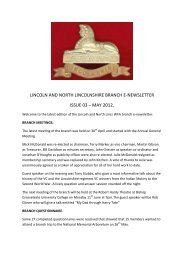
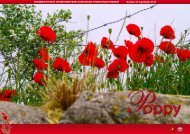
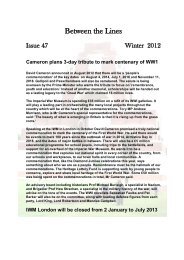
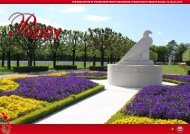
![Fromelles Australian Working List[1].pdf - The Western Front ...](https://img.yumpu.com/29972632/1/184x260/fromelles-australian-working-list1pdf-the-western-front-.jpg?quality=85)
